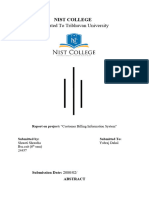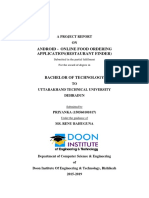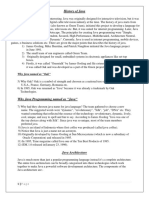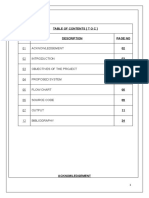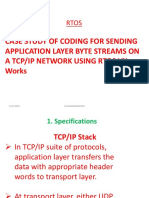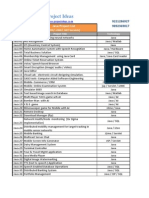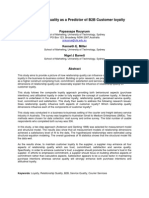Mini Project Report - Java Based Email Server System
Uploaded by
GokulsuriMini Project Report - Java Based Email Server System
Uploaded by
Gokulsuri[Type text]
Mini Project Report on
Intelligent Email Server System based on Java
By Gokul.S (1SI09CS028) Darshan.M(1SI09CS024) B.Niket(1SI09CS022)
GUIDE Prof.Kallinatha.H.D. B.E,M.Tech
(Associate professor)
Department of computer science & engineering Siddaganga institute of technology, Tumkur-572103
2011-12
[Type text]
Chapter
1
Chapter title
INTRODUCTION
Page
1
[Type text]
1. Introduction
1.1 Motivation
In this project, we developed our own e-mail server software in Java. The first motivation was that a Java server program can run on any operating system supporting the Java Virtual Machine environment rather than being specific to one operating system. Another motivation was the opportunity to learn a great deal about e-mail protocols, particularly the widely utilized ones, by actually building my own e-mail server software. It gave me not only a theoretical understanding of how e-mail protocols and user account management systems work, but also allowed me to move from theory into actual practice. In addition, the server can be extended in future to other Transmission Control Protocol (TCP)-based server applications for the convenience to other developers who may wish to use my work.
1.2 Objectives
Before undertaking this project, we first had to identify the functionality that must be implemented in order to run our program on a personal computer. To accept basic Simple Mail Transfer Protocol (SMTP) and Post Office Protocol (POP3) requests from e-mail clients, we applied extensions of the TCP server working model to both SMTP and POP3. And to aid management of the e-mail servers and user accounts, we decided to focus on designing and developing basic user account management functionalities first. We then added advanced functionalities later, such as more sophisticated commands to manage servers and accounts. When it was completed, we would compile all the sources into a JAR file so that all classes are ready for future reuse. After completing the first stage of development, we will create a graphical user interface for my server based on a basic version that allows the administrator to manage servers and accounts systems without having to remember and type commands into a command terminal.
[Type text]
2. Literature Survey
2.1 Background
In this project, we were required to research on literature related to e-mail protocol specifications and detailed examples of TCP network implementations in Java before we could iteratively practice designs and implementations for the e-mail server. Further, other literature discusses the TCP network implementation in Java that would help us to design and implement the e-mail protocols.
2.2 Email Protocol Literature
2.2.1 Simple Mail Transfer Protocol (SMTP) SMTP is an e-mail protocol that enables an e-mail client to send an e-mail message to an SMTP server. The user of the e-mail client does not require a user account and a password registered on the SMTP server to send a message, but some advanced email server systems may require user authentication by accessing an SMTP server. By default, TCP port 25 needs to be available to accept SMTP clients. However, some SMTP servers open a different port number. One reason for this would be to prevent massive spam e-mail traffic to the default port 25 of the SMTP server. SMTP is supported by the proposed e-mail server software since this protocol is widely used all over the world; almost all e-mail servers and clients accept SMTP for e-mail transmission.
2.2.2 Post Office Protocol 3 (POP3) POP3 is also an e-mail protocol that enables an e-mail client to receive an e-mail message from a POP3 server. The user of the e-mail client must have a user account and a password registered on the POP3 server to access his/her e-mail box. By default, TCP port 110 needs to be available to accept POP3 clients.
[Type text]
POP3 is also supported by the proposed e-mail server software since this protocol is used globally and almost all e-mail servers and clients accept this protocol.
3.3 Java Literature
3.3.1 Design Patterns Design patterns helped me to design and implement the proposed e-mail server efficiently. These patterns were particularly useful for developing my e-mail server software because the code organizations were complicated; however, I have to provide extensions for future developments. From the literature that I referenced, there are 23 three basic design patterns that I could use. 3.3.2 Input/Output Text input/output is for the communication between a server and its clients; this communication is required to transmit e-mail protocol commands and their responses. It is also for writing and reading the user account data that are to be saved. 3.3.3 TCP Network TCP network communication between a server and its clients is possible by using Socket classes provided in the java.net package. It is useful to implement the Socket for both SMTP and POP3 servers and their clients since the TCP communication protocol has already been implemented in a Socket class. This implies that there is no need to rewrite any specifications at the TCP-layer level or below; therefore, I can concentrate on the implementation of Application-layer protocols, i.e. SMTP and POP3. 3.3.4 Data Structure List data structures are extensively implemented in order to dynamically store objects. I used two different list data structures for the e-mail server software. 3.3.4.1 Array List One is the Array List data structure. The advantage of implementing this data structure is that it provides an efficient random access to the list specified by an index. However, the disadvantage is that this data structure constructs an array each time the size of the list is changed. This may be inefficient if the list changes many times while the program is being executed. 3.3.6.2 Linked List The other list data structure is the Linked List. The advantage of implementing this data structure is that this list allows flexible size changes while the program is running. This implies that efficient insertions and deletions can be made without rebuilding the entire data structure. On the other hand,
[Type text]
the disadvantage is that the random access of the data may consume more time than the data access
You might also like
- NetCracker Technology Interview Questions and Answers 45334No ratings yetNetCracker Technology Interview Questions and Answers 4533413 pages
- University of Southern California Statement of Account: Account Summary Current AddressNo ratings yetUniversity of Southern California Statement of Account: Account Summary Current Address3 pages
- MNNIT Allahabad B.Tech (Information Technology) SyllabusNo ratings yetMNNIT Allahabad B.Tech (Information Technology) Syllabus57 pages
- "Mobile Billing System": A Project Report ONNo ratings yet"Mobile Billing System": A Project Report ON64 pages
- Research On Mail System: Project Report For Bachelor in Computer - Rajendra Man Banepali100% (5)Research On Mail System: Project Report For Bachelor in Computer - Rajendra Man Banepali51 pages
- Project - 7 - Cyber Cafe Management SystemNo ratings yetProject - 7 - Cyber Cafe Management System32 pages
- Event Registration: Minor Project Report OnNo ratings yetEvent Registration: Minor Project Report On37 pages
- Android - Online Food Ordering Application (Restaurant Finder)No ratings yetAndroid - Online Food Ordering Application (Restaurant Finder)54 pages
- Django E Commerce Website PROJECT REPORTNo ratings yetDjango E Commerce Website PROJECT REPORT54 pages
- A.Data Flow Diagram Level 0 DFD: Log in Authentication Post Office Management SystemNo ratings yetA.Data Flow Diagram Level 0 DFD: Log in Authentication Post Office Management System3 pages
- Srs For Social Networking Application - Whatsapp: Prepared by 1781035, 1781047, 1781215, 1881111100% (1)Srs For Social Networking Application - Whatsapp: Prepared by 1781035, 1781047, 1781215, 18811115 pages
- Collaborative File Sharing System Phase INo ratings yetCollaborative File Sharing System Phase I29 pages
- Computer Shop Inventory System: Context Level DiagramNo ratings yetComputer Shop Inventory System: Context Level Diagram10 pages
- Patan Multiple Campus: Tribhuvan UniversityNo ratings yetPatan Multiple Campus: Tribhuvan University61 pages
- Hospital Location System Using Google MapNo ratings yetHospital Location System Using Google Map33 pages
- Software Requirement Specification For E - HealthcareNo ratings yetSoftware Requirement Specification For E - Healthcare10 pages
- Curriculum Vitae Ravi Jain: Atlas Atlas AtlasNo ratings yetCurriculum Vitae Ravi Jain: Atlas Atlas Atlas2 pages
- Expenses Calculation Mechanism For Any App .No ratings yetExpenses Calculation Mechanism For Any App .69 pages
- Mini Project Report Java Based Email Server System PDFNo ratings yetMini Project Report Java Based Email Server System PDF6 pages
- Advanced Socket Programming Socket Timeouts Interruptible Sockets Half-Close Internet Address Java Mail Messaging SystemNo ratings yetAdvanced Socket Programming Socket Timeouts Interruptible Sockets Half-Close Internet Address Java Mail Messaging System33 pages
- FrozenOrb / Staminus Communications LetterNo ratings yetFrozenOrb / Staminus Communications Letter2 pages
- (Studyplan) Assistant Provident Fund Commissioner (APFC) by UPSC - MrunalNo ratings yet(Studyplan) Assistant Provident Fund Commissioner (APFC) by UPSC - Mrunal18 pages
- Relationship Quality As A Predictor of B2B Customer LoyaltyNo ratings yetRelationship Quality As A Predictor of B2B Customer Loyalty16 pages
- Honeywell Sample Logical and Analytical Reasoning Placement Paper100% (1)Honeywell Sample Logical and Analytical Reasoning Placement Paper6 pages
- Understanding The Time-Series Behavioral Characteristics of Evolutionally Advanced Email SpammersNo ratings yetUnderstanding The Time-Series Behavioral Characteristics of Evolutionally Advanced Email Spammers9 pages
- Are POP and POP3 The Same Thing?: Client-Server ModelNo ratings yetAre POP and POP3 The Same Thing?: Client-Server Model6 pages
- Bizhub 283 - All Active Solutions: February 2013No ratings yetBizhub 283 - All Active Solutions: February 2013149 pages













